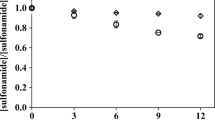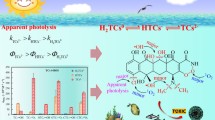Abstract
The purpose of this study was to investigate the aqueous phase photochemical behavior of enoxacin (ENO), an antibiotic selected as a model pollutant of emerging concern. The second-order reaction rate constants of ENO with hydroxyl radicals (HO●) and singlet oxygen (1O2) were determined at pH 3, 7, and 9. Also, the rate constants of the electron transfer reaction between ENO and triplet states of chromophoric dissolved organic matter (3CDOM*) are reported for the first time, based on anthraquinone-2-sulfonate (AQ2S) as CDOM proxy. The sunlight-driven direct and indirect ENO degradation in the presence of dissolved organic matter (DOM) is also discussed. The results show that direct photolysis, which occurs more rapidly at higher pH, along with the reactions with HO● and 3AQ2S*, is the key pathway involved in ENO degradation. The ENO zwitterions, prevailing at pH 7, show kENO, HO●, kENO,1O2, and kENO,3AQ2S* of (14.0 ± 0.8) × 1010, (3.9 ± 0.2) × 106, and (61.5 ± 0.7) × 108 L mol−1 s−1, respectively, whose differences at pH 3, 7, and 9 are due to ENO pH-dependent speciation and reactivity. These k values, along with the experimental ENO photolysis quantum yield, were used in mathematical simulations for predicting ENO persistence in sunlit natural waters. According to the simulations, dissolved organic matter and water depth are expected to have the highest impacts on ENO half-life, varying from a few hours to days in summertime, depending on the concentrations of relevant waterborne species (organic matter, NO3−, NO2−, HCO3−).






Similar content being viewed by others
Explore related subjects
Discover the latest articles and news from researchers in related subjects, suggested using machine learning.References
al Housari F, Vione D, Chiron S, Barbati S (2010) Reactive photoinduced species in estuarine waters. Characterization of hydroxyl radical, singlet oxygen and dissolved organic matter triplet state in natural oxidation processes. Photochem Photobiol Sci 9:78–86
Albini A, Monti S (2003) Photophysics and photochemistry of fluoroquinolones. Chem Soc Rev 32:238–250
Arques A, Bianco Prevot A (2015) Soluble bio-based substances isolated from urban wastes: environmental applications. Springer International Publishing, ISBN 978-3-31914744-4 (eBook), https://doi.org/10.1007/978-3-319-14744-4
Barbieri Y, Massad WA, Diaz DJ, Sanz J, Amat-Guerri F, Garcia NA (2008) Photodegradation of bisphenol a and related compounds under natural-like conditions in the presence of riboflavin: kinetics, mechanism and photoproducts. Chemosphere 73:564–571
Batista APS, Teixeira A, Cooper WJ, Cottrell BA (2016) Correlating the chemical and spectroscopic characteristics of natural organic matter with the photodegradation of sulfamerazine. Water Res 93:20–29
Bedini A, De Laurentiis E, Sur B, Maurino V, Minero C, Brigante M, Mailhot G, Vione D (2012) Phototransformation of anthraquinone-2-sulphonate in aqueous solution. Photochem Photobiol Sci 11:1445–1453
Bodrato M, Vione D (2014) APEX (aqueous photochemistry of environmentally occurring Xenobiotics): a free software tool to predict the kinetics of photochemical processes in surface waters. Environ Sci-Proc Imp 16:732–740
Boreen AL, Arnold WA, McNeill K (2004) Photochemical fate of sulfa drugs in the aquatic environment: sulfa drugs containing five-membered heterocyclic groups. Environ Sci Technol 38:3933–3940
Boreen AL, Arnold WA, McNeill K (2005) Triplet-sensitized photodegradation of sulfa drugs containing six-membered heterocyclic groups: identification of an SO2 extrusion photoproduct. Environ Sci Technol 39:3630–3638
Carlos L, Martire DO, Gonzalez MC, Gomis J, Bernabeu A, Amat AM, Arques A (2012) Photochemical fate of a mixture of emerging pollutants in the presence of humic substances. Water Res 46:4732–4740
De Laurentiis E, Prasse C, Ternes TA, Minella M, Maurino V, Minero C, Sarakha M, Brigante M, Vione D (2014) Assessing the photochemical transformation pathways of acetaminophen relevant to surface waters: transformation kinetics, intermediates, and modelling. Water Res 53:235–248
Edhlund BL, Arnold WA, McNeill K (2006) Aquatic photochemistry of nitrofuran antibiotics. Environ Sci Technol 40:5422–5427
Elovitz MS, von Gunten U (1999) Hydroxyl radical ozone ratios during ozonation processes. I-the R-ct concept. Ozone-Sci Eng 21:239–260
Escalada JP, Arce VB, Porcal GV, Biasutti MA, Criado S, Garcia NA, Martire DO (2014) The effect of dichlorophen binding to silica nanoparticles on its photosensitized degradation in water. Water Res 50:229–236
Fabbri D, Minella M, Maurino V, Minero C, Vione D (2015) A model assessment of the importance of direct photolysis in the photo-fate of cephalosporins in surface waters: possible formation of toxic intermediates. Chemosphere 134:452–458
Fick J, Soderstrom H, Lindberg RH, Phan C, Tysklind M, Larsson DGJ (2009) Contamination of surface, ground, and drinking water from pharmaceutical production. Environ Toxicol Chem 28:2522–2527
Gangwang, Liu GG, Liu HJ, Zhang N, Wang YL (2012) Photodegradation of salicylic acid in aquatic environment: effect of different forms of nitrogen. Sci Total Environ 435:573–577
Gao SQ, Jin HY, You JY, Ding Y, Zhang N, Wang Y, Ren RB, Zhang R, Zhang HQ (2011) Ionic liquid-based homogeneous liquid-liquid microextraction for the determination of antibiotics in milk by high-performance liquid chromatography. J Chromatogr A 1218:7254–7263
Ge LK, Na GS, Zhang SY, Li K, Zhang P, Ren HL, Yao ZW (2015) New insights into the aquatic photochemistry of fluoroquinolone antibiotics: direct photodegradation, hydroxyl-radical oxidation, and antibacterial activity changes. Sci Total Environ 527:12–17
Guerard JJ, Miller PL, Trouts TD, Chin YP (2009) The role of fulvic acid composition in the photosensitized degradation of aquatic contaminants. Aquat Sci 71:160–169
Hessler DP, Gorenflo V, Frimmel FH (1993) Degradation of aqueous atrazine and Metazachlor solutions by UV and UV/H2O2 - influence of pH and herbicide concentration. Acta Hydrochirn Hydrobiol 21:209–214
Ji YF, Zhou L, Zhang Y, Ferronato C, Brigante M, Mailhot G, Yang X, Chovelon JM (2013) Photochemical degradation of sunscreen agent 2-phenylbenzimidazole-5-sulfonic acid in different water matrices. Water Res 47:5865–5875
Larsson DGJ, de Pedro C, Paxeus N (2007) Effluent from drug manufactures contains extremely high levels of pharmaceuticals. J Hazard Mater 148:751–755
Li K, Zhang P, Ge LK, Ren HL, Yu CY, Chen XY, Zhao YF (2014) Concentration-dependent photodegradation kinetics and hydroxyl-radical oxidation of phenicol antibiotics. Chemosphere 111:278–282
Liu YM, Shi YM, Liu ZL (2010) Determination of enoxacin and ofloxacin by capillary electrophoresis with electrochemiluminescence detection in biofluids and drugs and its application to pharmacokinetics. Biomed Chromatogr 24:941–947
Lorenzo F, Navaratnam S, Edge R, Allen NS (2009) Primary Photoprocesses in a Fluoroquinolone antibiotic Sarafloxacin. Photochem Photobiol 85:886–894
Maddigapu PR, Minella M, Vione D, Maurino V, Minero C (2011) Modeling Phototransformation reactions in surface water bodies: 2,4-Dichloro-6-Nitrophenol as a case study. Environ Sci Technol 45:209–214
Marchetti G, Minella M, Maurino V, Minero C, Vione D (2013) Photochemical transformation of atrazine and formation of photointermediates under conditions relevant to sunlit surface waters: laboratory measures and modelling. Water Res 47:6211–6222
Montoneri E, Boffa V, Savarino P, Perrone D, Ghezzo M, Montoneri C, Mendichi R (2011) Acid soluble bio-organic substances isolated from urban bio-waste. Chemical composition and properties of products. Waste Manag 31:10–17
Mostafa S, Rosario-Ortiz FL (2013) Singlet oxygen formation from wastewater organic matter. Environ Sci Technol 47:8179–8186
Parsons S (2004) Advanced oxidation processes for water and wastewater treatment. IWA Publishing, London
Passananti M, Temussi F, Iesce MR, Previtera L, Mailhot G, Vione D, Brigante M (2014) Photoenhanced transformation of nicotine in aquatic environments: involvement of naturally occurring radical sources. Water Res 55:106–114
Perisa M, Babic S, Skoric I, Fromel T, Knepper TP (2013) Photodegradation of sulfonamides and their N (4)-acetylated metabolites in water by simulated sunlight irradiation: kinetics and identification of photoproducts. Environ Sci Pollut R 20:8934–8946
Porras J, Bedoya C, Silva-Agredo J, Santamaria A, Fernandez JJ, Torres-Palma RA (2016) Role of humic substances in the degradation pathways and residual antibacterial activity during the photodecomposition of the antibiotic ciprofloxacin in water. Water Res 94:1–9
Schwarzenbach RP (2003) Environmental organic chemistry. Second edition. Wiley & Sons, Inc., Hoboken
Silva MP, Mostafa S, McKay G, Rosario-Ortiz FL, Teixeira A (2015) Photochemical fate of Amicarbazone in aqueous media: laboratory measurement and simulations. Environ Eng Sci 32:730–740
Sortino S, De Guidi G, Giuffrida S, Monti S, Velardita A (1998) pH effects on the spectroscopic and photochemical behavior of Enoxacin: a steady-state and time-resolved study. Photochem Photobiol 67:167–173
Stefan MI, Bolton JR (2002) UV direct photolysis of N-Nitrosodimethylamine (NDMA): kinetic and product study. Helv Chim Acta 85:1416–1426
Tong CL, Xiang GH (2007) Sensitive determination of enoxacin by its enhancement effect on the fluorescence of terbium(III)-sodium dodecylbenzene sulfonate and its luminescence mechanism. J Lumin 126:575–580
Vione D, Maddigapu PR, De Laurentiis E, Minella M, Pazzi M, Maurino V, Minero C, Kouras S, Richard C (2011) Modelling the photochemical fate of ibuprofen in surface waters. Water Res 45:6725–6736
Xie Q, Chen J, Zhao H, Qiao X, Cai X, Li X (2013) Different photolysis kinetics and photooxidation reactivities of neutral and anionic hydroxylated polybrominated diphenyl ethers. Chemosphere 90:188–194
Acknowledgements
The authors express their gratitude to FAPESP (São Paulo Research Foundation, grant #2016/03695-8) and to Prof. Neyde Y. M. Iha (Laboratory of Photochemistry and Energy Conversion of the Institute of Chemistry, University of São Paulo, Brazil).
Author information
Authors and Affiliations
Corresponding authors
Additional information
Responsible editor: Suresh Pillai
Rights and permissions
About this article
Cite this article
Lastre-Acosta, A.M., Barberato, B., Parizi, M.P.S. et al. Direct and indirect photolysis of the antibiotic enoxacin: kinetics of oxidation by reactive photo-induced species and simulations. Environ Sci Pollut Res 26, 4337–4347 (2019). https://doi.org/10.1007/s11356-018-2555-4
Received:
Accepted:
Published:
Issue Date:
DOI: https://doi.org/10.1007/s11356-018-2555-4




